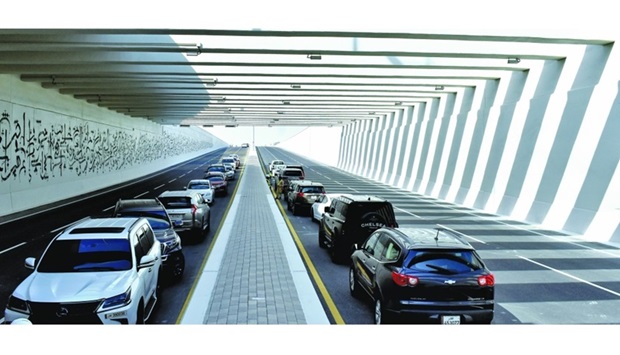The Public Works Authority (Ashghal) Saturday opened a 3.5km 'developed' section of the D-Ring Road and the tunnel of Fereej Al Ali (Al Tadamon) Intersection to traffic.
The work implemented as part of the D-Ring Road Development Project will reduce travel time by about 70%, Ashghal has said.

This part of the project included three intersections - Fereej Al Ali (Al Tadamon), Nuaija (The Mall) and the LuLu Intersection - which were also opened Saturday. The development works included increasing the number of lanes from three to four in each direction, raising the road's capacity to about 16,000 vehicles per hour from the earlier 12,000 vehicles per hour.

Projects Affairs manager Yousef al-Emadi told Gulf Times that the development ensures increased traffic flow between the D-Ring Road and Doha Expressway while serving several areas such as Nuaija, Al Hilal, Old Airport and many commercial, educational and health facilities.
The work implemented as part of the D-Ring Road Development Project will reduce travel time by about 70%, Ashghal has said.

A view of the LuLu Intersection. Supplied picture
This part of the project included three intersections - Fereej Al Ali (Al Tadamon), Nuaija (The Mall) and the LuLu Intersection - which were also opened Saturday. The development works included increasing the number of lanes from three to four in each direction, raising the road's capacity to about 16,000 vehicles per hour from the earlier 12,000 vehicles per hour.
Officials being briefed on some features of the project. PICTURE: Thajudheen
Projects Affairs manager Yousef al-Emadi told Gulf Times that the development ensures increased traffic flow between the D-Ring Road and Doha Expressway while serving several areas such as Nuaija, Al Hilal, Old Airport and many commercial, educational and health facilities.
 Yousef al-Emadi |
“Ashghal is keen to develop and establish an integrated road network as part of its plan that aims to achieve a developed highway network that links all areas in the country. Various roads such as Rawdat Al Khail Street, E-Ring Road and Najma Street that serve densely populated areas such as Al Hilal, Old Airport and Nuaija, join D-Ring Road all the way to New Slata and Doha Expressway,” he noted.
 Bader Darwish Bader Darwish |

A top view of the Fereej Al Ali (Al Tadamon) Intersection. Supplied picture
The project also includes developing rainwater drainage networks by constructing a tunnel with a total length of about 3.5km. Also, it includes developmental works for all infrastructure services, which have been updated for services such as water, electricity, drainage and communications networks.

A view of the newly opened tunnel. PICTURE: Thajudheen
Materials used for the project included 17,000 tonnes of steel, 100,000 tonnes of asphalt and 105,000sqm of concrete.
Al-Emadi explained that about 66% of locally made materials such as lighting poles, cables, rebar, drainage pipes, and others were used in the project.
Officials at the opening yesterday. PICTURE: Thajudheen
Highway Projects Department manager Bader Darwish said the D-Ring works faced several challenges as the road is located in the heart of Doha, linking traffic between Airport Street and Doha Expressway, crossing onto major streets such as the congested Najma and Rawdat Al Khail streets and many vital businesses.
 Mohamed Sami |
“The remaining works of the project, such as service roads, are being completed, in addition to the 4.5km pedestrian and cycling lane on both sides of D-Ring Road and landscaping works throughout the project,” he said.
Mohamed Sami from the Highway Projects Department said the new tunnel was built using pre-cast concrete and a new method to avoid obstructing traffic as works were implemented from top to bottom; starting with the roof of the tunnel and the supporting foundations, then excavation works.
 Abdulla Darwish |
Lieutenant Khalid al-Mulla, representative of the General Directorate of Traffic, said the development of D-Ring Road, especially the new tunnel, and an increase in the number of lanes will enhance traffic flow in the area.

One end of the tunnel. PICTURE: Thajudheen
 Lieutenant Khalid al-Mulla |
 Abdulrahman al-Khulaifi |
The Qatari heritage of the area surrounding the project, known as Rawdat Al Khail, was considered during the design phase of the tunnel, as murals inspired by the Qatari heritage were included inside the tunnel.

